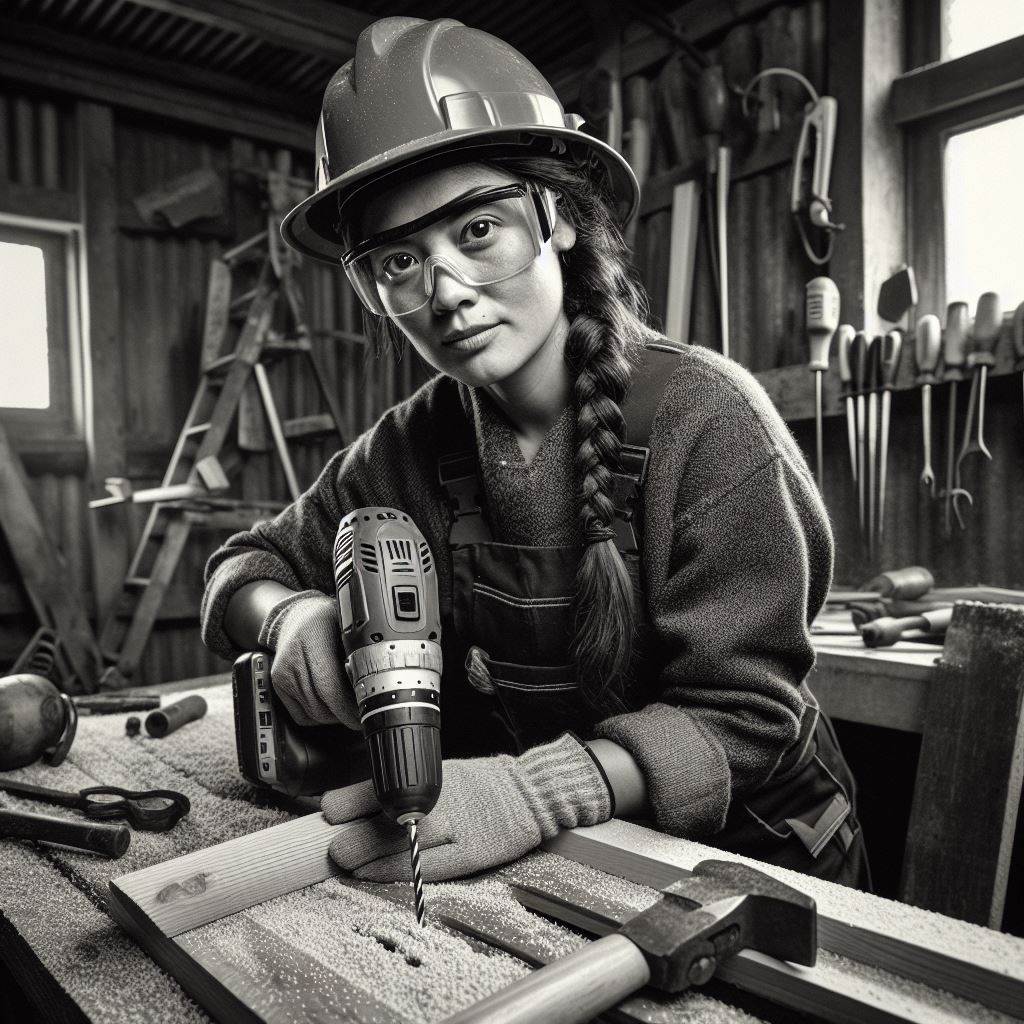Introduction
Carpentry innovation in New Zealand
Carpentry innovation in New Zealand is a topic of great significance for the future of the country’s carpentry industry.
The importance of innovation cannot be overstated as it plays a crucial role in shaping the future of carpentry in New Zealand.
Innovation drives progress and allows carpenters to stay competitive in the ever-evolving industry.
New Zealand’s carpentry sector has always been known for its high-quality craftsmanship and attention to detail.
However, in today’s rapidly changing world, it is imperative for carpenters to embrace innovation to stay relevant and meet the increasing demands of clients.
Importance of innovation for the future of carpentry in the country
Innovation in carpentry involves finding new ways to enhance efficiency, improve productivity, and deliver better results.
It encompasses the use of advanced tools, techniques, and materials that can revolutionize the traditional methods of carpentry.
By embracing innovation, carpenters can significantly reduce construction time, minimize waste, and enhance sustainability.
Innovative practices such as prefabrication, modular construction, and digital fabrication are transforming the way structures are built.
Moreover, innovation in carpentry opens doors to new opportunities and markets.
With the rising interest in sustainable and eco-friendly construction practices, innovative carpenters can tap into this growing sector and offer unique solutions.
Additionally, innovation fosters collaboration and knowledge sharing among carpenters, architects, engineers, and other industry stakeholders.
This collaborative approach encourages the development of new ideas and solutions that push the boundaries of carpentry.
Basically, carpentry innovation is vital for the future of the industry in New Zealand.
Embracing innovation allows carpenters to stay ahead in a competitive market, deliver high-quality results, and contribute to the overall growth of the construction sector.
Innovation is the key to unlocking new possibilities and shaping a bright future for carpentry in New Zealand.
Traditional Carpentry Practices
Traditional methods and practices used in carpentry in New Zealand
Carpentry in New Zealand has a rich history of traditional methods and practices. These time-honored techniques have been passed down through generations, shaping the industry as we know it today.
One of the traditional practices used in carpentry is hand tools. Carpenters would rely on tools like chisels, planes, and saws to shape and manipulate wood.
This manual approach required skill and precision, with every cut and measurement carefully calculated.
In addition to hand tools, traditional carpenters would often use joinery techniques such as dovetails and mortise and tenons.
These methods allowed carpenters to create strong and durable connections between pieces of wood without relying on nails or screws.
Furthermore, traditional carpentry practices involved using locally sourced timber. New Zealand has an abundance of native wood species, including rimu, kauri, and totara.
Carpenters would carefully select the right timber for each project, taking into account factors such as grain patterns and durability.
However, despite the advantages of traditional carpentry practices, there are also limitations and challenges faced by carpenters.
Limitations and challenges faced by carpenters with these traditional practices
One limitation is the time-consuming nature of hand tools. While these tools allow for precise craftsmanship, they can significantly slow down the construction process.
In today’s fast-paced world, carpenters often need to meet tighter deadlines, making it difficult to solely rely on traditional hand tools.
Another challenge faced by carpenters is the availability of quality timber. As the demand for traditional native timber has increased, the supply has dwindled.
Carpenters now need to source timber from sustainable sources or make use of alternative materials, which can be a departure from the traditional practices they are accustomed to.
Moreover, the reliance on joinery techniques can also pose challenges. While these methods create strong connections, they require extensive skill and experience to execute properly.
As the number of skilled traditional carpenters decreases, finding individuals proficient in these techniques becomes increasingly difficult.
Personalized Career Consulting
Unlock your potential with expert career advice tailored to your goals. Get personalized guidance and actionable steps toward your dream career in New Zealand.
Get StartedTo address these limitations, carpentry in New Zealand is embracing innovation and incorporating modern practices.
Power tools have revolutionized the carpentry industry, allowing for faster and more efficient construction.
Electric saws, drills, and routers have become commonplace on construction sites, speeding up the process without compromising precision.
Additionally, advancements in engineered wood products have provided carpenters with alternative materials that are durable, sustainable, and readily available.
These materials, such as laminated veneer lumber and engineered timber, offer increased strength and stability compared to traditional timber.
Furthermore, the rise of prefabrication and modular construction has also impacted carpentry practices.
Off-site construction allows for precise manufacturing and assembly, reducing construction time and minimizing on-site waste.
Therefore, while traditional carpentry practices have laid the foundation for the industry in New Zealand, it is essential to adapt and embrace innovation.
By combining traditional craftsmanship with modern techniques and materials, carpenters can overcome the limitations of the past and meet the demands of the future.
Technological Advancements
In recent years, the carpentry industry in New Zealand has witnessed significant technological advancements that have revolutionized the way tasks are carried out.
These advancements have greatly improved efficiency and productivity, resulting in high-quality craftsmanship and reduced labor time. Let’s explore some of these breakthrough innovations:
Advanced Tools
- Power tools such as cordless drills, nail guns, and electric saws have become essential for carpenters.
- These tools enable faster and more precise cutting, drilling, and fastening, leading to increased productivity.
- The introduction of laser-guided measurement devices has significantly improved accuracy and reduced human error.
- Cutting-edge power tools have enhanced ergonomics, making the work less strenuous for carpenters.
3D Printing
- 3D printing technology has revolutionized the way carpenters create prototypes and models.
- By utilizing computer-aided design (CAD) software, carpenters can now print 3D models of their designs.
- This allows for better visualization and enables clients to provide valuable feedback before construction begins.
- Moreover, 3D printing eliminates material waste, as only the necessary amount of material is used for each model.
Virtual Reality Simulations
- Virtual reality (VR) has found its way into the carpentry industry, providing immersive training experiences.
- Carpenters can now simulate complex construction scenarios and practice their skills in a safe virtual environment.
- VR training significantly reduces the risk of accidents and allows for experimentation with different techniques.
- This technology also facilitates collaboration among carpenters working on the same project but in different locations.
In addition to the advancements mentioned above, there are several other technological breakthroughs that deserve recognition.
Drones, for instance, are being used for aerial surveys and inspections of construction sites. These unmanned aerial vehicles provide detailed and real-time information, saving time and resources.
Furthermore, the use of Building Information Modeling (BIM) software allows carpenters to create accurate 3D models of buildings and analyze various construction parameters before commencing work.
This not only enhances accuracy but also helps in identifying potential issues and reducing rework.
The carpentry industry in New Zealand is rapidly evolving, thanks to these technological advancements. Carpenters are able to complete projects more efficiently, producing high-quality work in less time.
These innovations have also attracted more interest and talent to the industry, ensuring a promising future for carpentry in the country.
Generally, the technological advancements in the field of carpentry in New Zealand have brought about significant improvements in efficiency and productivity.
From advanced tools to 3D printing and virtual reality simulations, these innovations have revolutionized the way tasks are carried out.
Carpenters are now equipped with tools that enable faster and more precise work, while also benefiting from immersive training experiences.
As technology continues to advance, the carpentry industry can expect even further improvements in the years to come.
Sustainable and Eco-friendly Innovations
Growing focus on sustainability in the carpentry industry
In recent years, there has been a growing focus on sustainability in the carpentry industry.
Carpenters are now looking for innovative ways to use environmentally-friendly materials and practices, and this shift towards sustainability has brought about some exciting developments in New Zealand.
One of the most significant changes in the carpentry industry is the increased use of recycled timber.
In the past, it was common for builders to use newly sourced timber, contributing to deforestation and environmental degradation.
However, carpenters in New Zealand are now prioritizing the use of recycled timber as a sustainable alternative.
Recycled timber is sourced from old buildings, bridges, and other structures that are no longer in use. This timber is then carefully salvaged and processed, removing any nails or other contaminants.
Using recycled timber not only reduces the demand for newly sourced timber but also prevents valuable building materials from going to waste.
Innovative ways carpenters are using environmentally-friendly materials and practice
Another sustainable innovation in the carpentry industry is the adoption of eco-friendly building techniques.
Carpenters are now using practices such as passive design and energy-efficient insulation to create more sustainable and energy-efficient buildings.
Passive design involves maximizing the use of natural light and ventilation in a building, reducing the need for artificial lighting and air-conditioning.
Carpenters are also incorporating energy-efficient insulation materials, such as recycled polyester or sustainable wood fiber, to improve the thermal performance of buildings.
Transform Your Career with a Professional CV and Cover Letter
Stand out to employers with an ATS-optimized resume and tailored cover letter designed to match your dream role. Let us craft your job application materials for success!
Get StartedNew Zealand is leading the way in sustainable carpentry innovation with several notable examples. One such example is the EcoMatters Environment Trust’s “Secondhand Spares” program.
This initiative collects unwanted building materials, including timber, and sells them at a fraction of the cost. It not only reduces waste but also provides affordable materials for carpenters.
Examples of sustainable innovations in New Zealand, such as recycled timber and eco-friendly building techniques
Another example of sustainable innovation is the use of hempcrete in construction. Hempcrete is a mixture of hemp fibers, lime, and water, which results in a lightweight and highly insulating material.
It has a negative carbon footprint, as the hemp plant absorbs more carbon dioxide during its growth than is emitted during the production of hempcrete.
Furthermore, carpenters in New Zealand are exploring the possibilities of using sustainable timber treatments instead of traditional chemical treatments.
These treatments, such as using natural oils or heat treatments, do not release harmful chemicals into the environment and are safer for both carpenters and occupants.
In general, the carpentry industry in New Zealand is undergoing a significant shift towards sustainability.
Carpenters are embracing innovative practices and materials, such as recycled timber and eco-friendly building techniques, to create more sustainable and environmentally-friendly structures.
With these sustainable innovations, the carpentry industry is contributing to a greener future for New Zealand.
Read: Carpentry 101: A Guide for Kiwi Beginners
Collaboration with Architects and Designers
Collaboration between carpenters, architects, and designers is crucial in the field of carpentry innovation.
This collaboration allows for the creation of innovative and unique carpentry projects that push the boundaries of traditional craftsmanship.
Importance of collaboration between carpenters, architects, and designers
The importance of collaboration between these professionals cannot be overstated.
Carpenters possess practical knowledge and expertise in their craft, while architects and designers bring a creative vision and understanding of the overall project.
Working together, they can tackle complex challenges and find creative solutions.
How this collaboration leads to innovative and unique carpentry projects
When carpenters, architects, and designers collaborate, it leads to the development of innovative carpentry projects.
By combining their skills and knowledge, they can create structures and designs that are unlike anything seen before.
The synergy generated from this collaboration allows for the exploration of new techniques and materials, resulting in groundbreaking designs.
Successful collaborations in New Zealand and their impact on the industry
In New Zealand, numerous successful collaborations between carpenters, architects, and designers have left a significant impact on the industry.
One such collaboration is the Len Lye Centre in New Plymouth. The project involved the collaboration of the internationally renowned architect Andrew Patterson with local carpenters and designers.
The result is a stunning building that seamlessly integrates art, design, and carpentry.
Another successful collaboration in New Zealand is the Cardboard Cathedral in Christchurch.
After the devastating earthquake, architect Shigeru Ban worked closely with local carpenters and designers to construct a temporary cathedral using cardboard tubes.
This innovative and unique design garnered worldwide recognition and showcased the power of collaboration in the face of adversity.
Collaboration with architects and designers also leads to advancements in sustainable building practices.
Through joint efforts, professionals in the industry can explore environmentally friendly materials and construction methods.
These collaborations have resulted in the use of recycled materials, energy-efficient designs, and sustainable building practices in carpentry projects across New Zealand.
Additionally, collaboration allows for the transfer of knowledge and skills between professionals.
Carpenters can learn new techniques from architects and designers, while architects can gain a deeper understanding of the practicalities of construction.
This exchange of knowledge strengthens the industry as a whole and fosters continuous innovation.
In review, collaboration between carpenters, architects, and designers is essential for carpentry innovation in New Zealand.
By working together, professionals can create innovative and unique projects that push the boundaries of traditional craftsmanship.
Successful collaborations in New Zealand have shown the impact of this collaboration on the industry, leading to groundbreaking designs and advancements in sustainable building practices.
Read: Top Carpentry Courses in New Zealand
Boost Your Career with a Standout LinkedIn Profile
Attract recruiters and expand your network with a fully optimized LinkedIn profile tailored to highlight your strengths and professional goals. Let your profile open doors to new opportunities!
Get Optimized
Training and Education
In order to foster innovation in the carpentry industry, continuous learning and training play a vital role.
Carpenters need to constantly update their skills and knowledge to keep up with the ever-changing demands and advancements in the field.
Importance of Continuous Learning and Training
Continuous learning allows carpenters to stay relevant and competitive in the industry.
With new technologies, materials, and techniques emerging, it is crucial for carpenters to regularly update their knowledge and skills.
By continuously learning and training, carpenters can improve their efficiency and productivity.
They can discover new methods or tools that can help them complete their tasks more effectively, resulting in better-quality workmanship.
Moreover, continuous learning enhances carpenters’ problem-solving abilities.
As they encounter different challenges on various projects, they can broaden their problem-solving skills by learning from experienced professionals or taking specialized courses.
Continuous learning also enables carpenters to adapt to changing regulations and codes within the industry.
Staying informed about the latest safety protocols and environmental standards is essential for delivering projects that comply with legal requirements.
Availability of Educational Programs and Courses
Recognizing the importance of continuous learning, numerous educational programs and courses are available to carpenters.
These programs aim to equip carpenters with the necessary skills and knowledge to meet industry demands.
Technical institutes, trade schools, and community colleges offer comprehensive carpentry programs.
These programs cover various aspects of the trade, such as blueprint reading, construction methods, and project management.
Furthermore, online platforms and e-learning resources provide convenient access to educational materials for carpenters.
They can participate in webinars, watch tutorial videos, or enroll in online courses to enhance their carpentry skills.
Government initiatives and industry associations often support educational programs by providing grants or scholarships to aspiring and practicing carpenters.
This financial assistance encourages individuals to invest in their training and development.
Role of Apprenticeships and Vocational Training
Apprenticeships and vocational training programs are essential in fostering innovation within the carpentry industry.
These hands-on learning experiences allow aspiring carpenters to gain practical skills under the guidance of experienced professionals.
By working alongside seasoned carpenters, apprentices can learn advanced techniques and industry best practices.
This mentorship not only improves their technical skills but also instills the importance of quality craftsmanship and attention to detail.
Apprenticeships are structured programs that combine on-the-job training with classroom instruction.
This blend of practical experience and theoretical knowledge equips apprentices with a well-rounded skill set and prepares them for a successful carpentry career.
Vocational training institutes also play a crucial role in providing specialized carpentry courses.
These institutes focus on practical skills development and often collaborate with industry partners to ensure their programs remain relevant and up-to-date.
By promoting apprenticeships and vocational training, the carpentry industry encourages a culture of innovation.
The combination of practical experience, learning opportunities, and exposure to new ideas fosters creativity and encourages carpenters to think outside the box.
Essentially, continuous learning and training are of utmost importance in the carpentry industry.
By embracing educational programs, courses, apprenticeships, and vocational training, carpenters can adapt to industry advancements, enhance their skills, and drive innovation within the field.
Read: Carpenter Apprenticeships in NZ Explained
Government Support and Initiatives
Government support plays a crucial role in fostering carpentry innovation in New Zealand.
Through various initiatives, grants, and programs, the government actively promotes and encourages the development of new ideas and technologies in the industry.
This support has a positive impact on the future of carpentry in the country.
Funding for Research and Development
The New Zealand government allocates significant funding for research and development in the carpentry sector.
This financial support enables carpenters and innovators to explore new techniques, materials, and processes. It encourages experimentation and the push for advancements in the field of carpentry.
Industry Partnerships and Collaborations
The government actively facilitates partnerships between the carpentry industry and educational institutions, research centers, and other relevant organizations.
These collaborations promote knowledge exchange and provide carpenters with access to resources, expertise, and cutting-edge technology.
It encourages innovation and helps carpenters stay up-to-date with the latest industry trends.
Skill Development Programs
To support the future of carpentry, the government implements skill development programs that provide training and education opportunities to aspiring carpenters.
These programs aim to fill the skills gap in the industry by equipping individuals with the necessary knowledge and expertise.
By investing in skilled workers, the government ensures a sustainable and innovative future for New Zealand’s carpentry industry.
Promotion of Sustainable Practices
The government recognizes the importance of sustainability in the carpentry sector and promotes initiatives that encourage eco-friendly practices.
Through grants and incentives, it supports carpenters in adopting sustainable materials, techniques, and designs.
This focus on sustainability not only benefits the environment but also drives innovation by encouraging carpenters to find new, greener solutions.
Research and Innovation Grants
The government offers grants specifically targeted towards carpentry research and innovation.
These grants provide financial support to individuals and organizations working on pioneering projects.
By incentivizing innovation, the government fosters a culture of creativity and problem-solving within the carpentry industry, leading to advancements and improved practices.
Recognition and Awards
The government acknowledges exceptional contributions to carpentry innovation through awards and recognition programs.
This recognition serves as a motivation for carpenters to continue pushing boundaries and striving for excellence. It highlights the importance of innovation in the industry and encourages others to follow suit.
Building Code and Regulation Updates
The government regularly updates building codes and regulations to align with technological advancements and changing industry standards.
By staying up-to-date with these changes, carpenters can incorporate innovative techniques and materials into their work.
This flexible regulatory environment allows for continuous improvement and encourages carpentry innovation.
In essence, the New Zealand government plays a vital role in supporting carpentry innovation through various initiatives, grants, and programs.
Its financial support, industry collaborations, and focus on sustainability create a conducive environment for the development and adoption of new technologies and practices.
By investing in research, education, and skill development, the government ensures a bright future for carpentry in New Zealand, fostering a culture of innovation and excellence in the industry.
Read: Kiwi Carpenter Salary Insights 2024
Conclusion
Carpentry innovation is crucial for the future of the industry in New Zealand.
Key points discussed in the blog post
Throughout this blog post, we explored the various innovative practices and advancements in carpentry that are shaping the industry.
From the use of sustainable materials to the integration of technology, these innovations are revolutionizing the way carpentry is done.
Importance of carpentry innovation for the future of the industry in New Zealand
Not only do these innovative practices lead to more efficient and cost-effective construction processes, but they also contribute to a more sustainable and environmentally friendly industry.
Encouraging readers to embrace and support innovative practices in carpentry
By embracing carpentry innovation, New Zealand can position itself as a leader in the construction sector, attracting investments and creating job opportunities.
It will help the industry stay competitive and adapt to changing customer demands.
It is crucial for all stakeholders, including carpenters, contractors, and policymakers, to actively support and promote innovative practices in carpentry.
Individuals working in the carpentry industry should seek out training and skill development opportunities to stay up-to-date with the latest techniques and technologies.
By supporting and embracing these innovations, we can not only improve the quality and efficiency of construction projects but also contribute to a more sustainable future for the industry in New Zealand.
Let us all support and encourage the adoption of carpentry innovation, ensuring a prosperous and thriving future for the carpentry industry in New Zealand.




